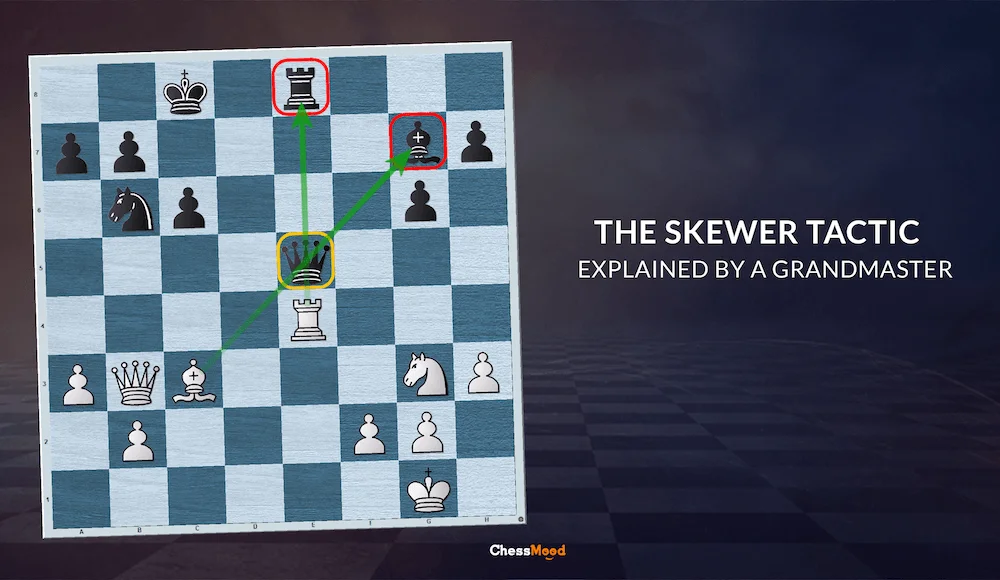The Skewer tactic explained by a Grandmaster!
Everything about the skewer in chess: from what it is, how it works to how to get out of it, and more!
Everything about the skewer in chess: from what it is, how it works to how to get out of it, and more!

We love skewers🙂– in chess and at our classic barbecue parties!
Wait, skewers in chess and barbecues? What’s the connection?
There is a lot actually. When I found out, I knew I had to share it.
So in this article, I’m not just going to cover everything around skewers, including:
Rather, I’m also going to give you a sneak peek of something we’re famous for (apart from chess courses, of course!).
Let’s go!
A skewer is a chess tactic that happens when the more valuable piece is attacked, and after moving it, a less valuable piece behind is left exposed.
Here’s an example:

Look at the position above – White has a Bishop on c3.
It attacks the Black Queen (the more valuable piece) standing in front of the Rook(the less valuable one). This is a skewer.
White ends up winning material.
All the long-ranging pieces can create a skewer – the Rook, the Bishop and the Queen.
Meanwhile, the King, Knight, and pawn cannot.
If you know what's a pin in chess, this may sound similar to you, but there is a difference which we will cover later.
Now since we’re talking about skewers, we can’t go without mentioning our barbecue parties🙂
You’ll soon see how it’s connected to the chess tactic.
Have you ever cooked a barbecue?
At ChessMood, we’re slowly and steadily making a name for ourselves for serving the best barbecues.

Chessable co-founder, barbecue and our team on the right
And when it comes to preparing the barbecue, we stock the ingredients and call our IM master chef.
He shows up like this…

Barbecue Grandmaster IM David Shahinyan
…and gets ready to cook!
Coming back, what’s the connection between a skewer in barbecue and chess?
So if you look closely at the above picture, David holds a pan in his right hand and a stick in his left one.
That stick is known as a skewer.
The skewer in a barbecue is the thin rod used to hold together the meat pieces as you grill them over the barbecue just like you see below.

And just like a barbecue skewer pierces through meat, a chess skewer pierces through 2 chess pieces, with the more valuable piece standing in front, just like the position below.

The Bishop skewering the Black Queen and Rook
Now that you have a clear basic picture of what this tactic is, let’s dive deeper into the topic.
There are 2 types, pretty similar to pins.
In this type, the King is the piece that’s skewered (first in the line of attack), and moving it exposes the less valuable piece behind.

As you can see, because the King is attacked first, Black is forced to get out of check. Hence this is a forcing type of this tactic.
When any other piece apart from a King comes under the direct line of attack, it’s known as a relative skewer.
Like in the position below:

Now, this tactic is very similar to that of the pin, but there’s a slight difference.
In a pin, the less valuable piece is first in the direct line of attack, while in the skewer, it’s the more valuable piece that stands first.
I’ll make everything clear with 2 pictures:

Position on pin vs position on skewer
As you can see in the diagram on pin, the Rook(a lesser valuable piece compared to the Queen) is first in the line of attack.
While in the other, the Queen (more valuable piece) stands first in the line of attack.
The first one is quite simple. It’s White to play and win.
In the next one, you’ll need to use your knowledge of 2 tactical patterns.
And here’s another one. It’s a little tough compared to the previous two.
Can you see how White to play wins?
In the last one, I’ll leave you with a little complex yet beautiful composition!
For more crazy examples, you can watch the video below.
Now there are many ways to get out of it. And as you become a better player, you’ll figure them out pretty much intuitively.
For now, I’ll share 5 of the most common escape methods.
This one is the most straightforward.
When you’re skewered, see if you can run away with the more valuable piece in such a way that it defends the weaker piece behind.
Here’s an example.

In the position above, White has just played 1.Bf4, attacking the Black Queen. How do you think Black should respond?
Another option you could have is to bail out of a skewer by giving a check. Take a look at the position below.

White Rook cannot retreat to defend the Bishop. Seems like White is in trouble.
But wait, there’s a way!
Sometimes, you could even consider blocking the skewering line with a lower-value piece or pawn. Like in the position below.
Another great option to get out of a skewer is to counterattack – meeting fire with fire!
For this, you need to see if either of your skewered pieces can deliver a threat.

In the above position, it’s Black to play. Can they get out of the uncomfortable skewer?
Try to think and solve before you see the solution below.
And just like counterattack, there will also be cases when you can use countertactics.
Take a look at the example below.

White has just played 1.Bd5. Is Black doomed? Or can they save themselves?
I'll leave you with a few more practical examples on getting out of skewers in the video below.
That’s all for the basics of the skewer tactic in chess!
You can find more advanced examples and step-by-step mini-lessons to strengthen your vision for this tactical theme in the Tactic Ninja course.

Our most popular course: Tactic Ninja
For those of you who love challenges, I’m leaving you with 4 test puzzles, all are White to play and win.
Position 1-2


Position 3-4


You can share your answers in the forum.
Wish you many victories and lots of skewers at your barbecue parties!
Originally published Mar 28, 2023

